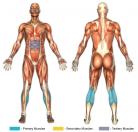Standing Calf Raises (Barbell)
- Place the barbell or smith machine bar at the correct height in the stand, then add the desired amount of weight. (The correct height is the height whereby there is a slight bend in your knees when your trapezius/shoulders are in contact with the bar.) Note: To achieve optimal calf recruitment it is necessary to place a large weight plate, wedge, or some other manner of sturdy elevated step beneath the bar that you will be executing your calf raises with.
- Stand (with the balls of your feet on the plate, wedge, or step, if you've emplaced one) underneath the bar and align it so that it is evenly balanced on your trapezius, and grasp the bar at a comfortable width keeping your elbows back.
- Isometrically contract your gluteals and abdominals, look forward (keep your eyes fixed on an object to best maintain balance), and stand erect to remove the barbell from the stand.
- If using a free-weight barbell, carefully step back a couple of steps, and ensure that your feet are positioned in the desired position (generally this means at around shoulder-width and aligned parallel to one another; see "Further Clarification" for elaboration on how to target different aspects of the calf muscles).
- Press with your feet (plantar flexion) until your calves are fully flexed, keeping your legs straight at the knees and the abdominals tensed, while exhaling throughout the positive aspect of the movement.
- Lower until your heels are lower than the feet plate (a deep stretch will be felt in the calves), and inhale throughout the (negative) aspect of the movement.
- Repeat steps 5-6 for as many repetitions as are desired.
If building calf mass is the goal, then lifting with heavy weights is almost unequivocally required. The calves are usually considered to be the most arduous muscle of the body to develop because they are accustomed to being worked constantly by the mere act of ambulating from place to place. The calves are capable of a notably high quantity of work. Getting results in calf strength, definition, or mass will, for most, require mental fortitude and strong, unwavering volition.
Likewise, if building calf endurance is the goal, then lifting with high repetitions is almost absolutely required. The same reason as above applies.
In theory, the feet can be positioned in different ways to change the focus of stress on the calf muscles. By pointing the feet outwards it is possible to isolate the inner calf (medial gastrocnemius) and, conversely, by pointing the feet inwards it is possible to isolate the outer calf (lateral gastrocnemius). For most, it will take practice to achieve this result, even with proper foot placement. Separating the stress put on the gastrocnemius from the soleus is much easier to accomplish. (e.g. Standing calf raises will work the gastrocnemius more, while seated calf raises will work the soleus more).
The weight should be such that you can raise up fully onto the balls of your feet for the majority of the repetitions. Once your calves are exhausted, finish you set by executing partial repetitions. The muscular burn you experience will likely be intense, but if you want results it the price that must be paid.
As with some other barbell exercises, balance is crucial with standing calf raises. Due to the fact that the calves can often handle a heavy amount of weight, it is highly important to remain focused and balanced to prevent injury. Caution should also be taken when loading heavy amounts of weight onto the shoulders due to the spinal compression that occurs.
Additionally, as with any heavy weight placed on the shoulders, an imprint from the device used may result from use whether it is a barbell or machine pad. While generally harmless, these imprints, depending on the severity, can last as long as three days.





